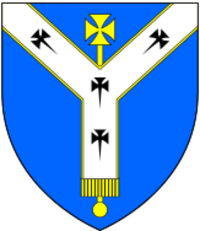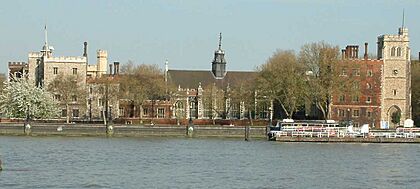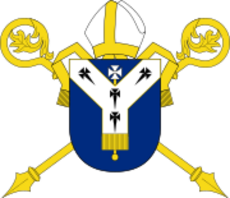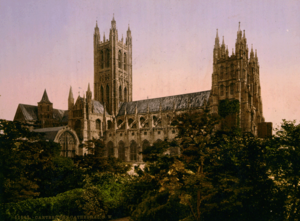Archbishop of Canterbury facts for kids
Quick facts for kids |
|
|---|---|

Coat of arms
|
|
| Location | |
| Ecclesiastical province | Canterbury |
| Information | |
| Denomination | Anglican |
| Established | 597 |
| Cathedral | Canterbury Cathedral |
The Archbishop of Canterbury is a very important leader in the Church of England. This person is the main bishop and a spiritual guide for Anglicans around the world. They are also the bishop for the area called the diocese of Canterbury.
The first Archbishop was Augustine of Canterbury. He was sent to England by Pope Gregory the Great in 597 AD. He is known as the "Apostle to the English" because he helped bring Christianity to England.
The position of Archbishop has been empty since January 7, 2025. This happened after Justin Welby, who was the 105th Archbishop, resigned. While the position is empty, Stephen Geoffrey Cottrell, the Archbishop of York, is taking on most of the Archbishop of Canterbury's duties.
On October 3, 2025, it was announced that Sarah Mullally will be the next Archbishop. She is currently the bishop of London. She will start her new role in January 2026.
For many centuries, the Archbishops of Canterbury were part of the Catholic Church. But during the English Reformation, King Henry VIII made changes to the church in England. He declared himself the head of the Church of England. Thomas Cranmer, who became Archbishop in 1533, was the first Protestant Archbishop of Canterbury. He helped shape what the Church of England is like today.
The British monarch officially appoints the Archbishop. This decision is made after getting advice from the prime minister of the United Kingdom. The college of canons at Canterbury Cathedral then formally elects the chosen person. A special group called the Crown Nominations Commission helps choose candidates for the prime minister.
Contents
What the Archbishop Does Today
The Archbishop of Canterbury has four main jobs:
- Bishop of Canterbury: They lead the diocese of Canterbury. This area covers the eastern part of Kent County in England. It is the oldest church area in England, started in 597 AD.
- Leader of the Province of Canterbury: They are the main bishop for the province of Canterbury. This province includes about two-thirds of southern England.
- Chief Religious Figure in the Church of England: The Archbishop is the most senior religious leader in the Church of England. The British sovereign (the King or Queen) is the official head of the church. The Archbishop works with the archbishop of York to lead the General Synod of the Church of England. They also help with important national events, like coronations. People often ask for their opinions in the news.
- Spiritual Leader of the Anglican Communion: The Archbishop is seen as the spiritual leader for Anglicans worldwide. They don't have legal power outside England. But they are respected as the "first among equals" among all Anglican leaders. Since 1867, the Archbishop has organized big meetings called Lambeth Conferences for Anglican bishops from all over the world.
In these last two roles, the Archbishop helps build bridges between different Christian groups and other religions. They speak for Anglicans in England and globally.
The Archbishop's main home is Lambeth Palace in London. They also have rooms in the Old Palace in Canterbury, next to Canterbury Cathedral. This is where the historic Chair of St Augustine is located.
The Archbishop of Canterbury is one of the "Lords Spiritual" in the House of Lords. This means they have a seat in the British Parliament. They are one of the highest-ranking non-royal people in the United Kingdom.
Since King Henry VIII's changes, the British monarch has chosen the Archbishops of Canterbury.
Justin Welby was the 105th Archbishop. He started his role on March 21, 2013. He signed his name as + Justin Cantuar. He announced his resignation on November 12, 2024, and left office on January 7, 2025.
Two other former Archbishops are still living: George Carey (born 1935), who was the 103rd Archbishop, and Rowan Williams (born 1950), the 104th Archbishop.
Other Important Roles
The Archbishop also holds many other important positions. For example, they are a joint president of the Council of Christians and Jews in the UK. They also serve as a Chancellor or Visitor for several universities and schools, including Canterbury Christ Church University and King's College London. They are also a patron for various charities and organizations.
Working with Other Faiths
The Archbishop works with other Christian churches in England through an organization called Churches Together in England. They also engage in dialogue with leaders of other religions.
For example, Geoffrey Fisher, the 99th Archbishop, was the first since 1397 to visit Rome and meet with Pope John XXIII in 1960. In 2005, Rowan Williams was the first Archbishop to attend a papal funeral since the Reformation.
Since 2002, the Archbishop has helped lead the Alexandria Middle East Peace process with the Grand Mufti of Egypt. In 2008, the Archbishop attended a meeting of Christians, Jews, and Muslims. This meeting, hosted by the king of Saudi Arabia, promoted understanding and cooperation among different faiths.
How the Role Began
Long ago, during the Roman Empire, there might have been important church leaders in cities like London and York. But in the 5th and 6th centuries, Germanic peoples called the Anglo-Saxons came to England. They were not Christian. The Kingdom of Kent, in southeast England, had strong connections with Europe. King Æthelberht of Kent married a Christian princess named Bertha of Kent. He allowed Christians to preach in his kingdom.
The first Archbishop of Canterbury was Saint Augustine of Canterbury. He arrived in Kent in 597 AD. Pope Gregory I sent him to share Christianity with the English people. King Æthelbert became Christian around 598 AD and accepted Augustine. The Pope had originally planned for new church centers in London and York. But because of local politics, Canterbury was chosen instead of London. Since then, the Archbishops of Canterbury have been said to sit in the "Chair of St. Augustine."
A very old gospel book, believed to be from St. Augustine's time, is still kept today. This book, called the St Augustine Gospels, is used when new Archbishops of Canterbury are sworn into office.
Before the 16th century, the Church of England was part of the wider European church led by the Pope. After the changes made by King Henry VIII, the Church of England became a national church. It still sees itself as part of the Western Christian tradition.
Canterbury's Church Areas
The Archbishop of Canterbury oversees the Province of Canterbury. This province includes 30 of the 42 church areas (dioceses) in the Church of England. The other dioceses are in the Province of York.
The Archbishop of Canterbury is considered the "first among equals" among all Anglican bishops worldwide. This means they have a special place of honor. However, they do not have direct power over church areas outside of England.
The Archbishop has four assistant bishops, called suffragan bishops:
- The bishop of Dover helps lead the Diocese of Canterbury. This is because the Archbishop is often busy with national and international duties.
- The bishop of Ebbsfleet and the bishop of Richborough are special bishops. They provide support to churches in the Province of Canterbury that have specific beliefs about church leadership.
- The bishop of Maidstone also provides support to churches in the Province of Canterbury with particular views on leadership. Rod Thomas became the Bishop of Maidstone on September 23, 2015.
Titles and Special Rights
Both the Archbishops of Canterbury and York are called "The Most Reverend." Retired Archbishops are called "The Right Reverend." The Archbishop is also usually a member of the Privy Council of the United Kingdom. This allows them to use the title "The Right Honourable" for life.
In official documents, the Archbishop of Canterbury is called "The Most Reverend [First Name], by Divine Providence Lord Archbishop of Canterbury, Primate of All England and Metropolitan." In the House of Lords, they are called "The Most Reverend Primate, the Archbishop of Canterbury." People can also address them as "Your Grace" or simply "Archbishop."
The Archbishop of Canterbury can legally sign their name using "Cantuar." This is a Latin word for Canterbury. For example, Justin Welby often signed as "+Justin Cantuar:".
In England and Wales, the Archbishop of Canterbury ranks very high in official order. They are above almost everyone except the King or Queen and the royal family. The lord chancellor and then the Archbishop of York are ranked just below them.
The Archbishop of Canterbury can also award special academic degrees, known as "Lambeth degrees."
Homes of the Archbishop

The Archbishop of Canterbury's official home and office in London is Lambeth Palace. They also have an apartment in the Old Palace, which is next to Canterbury Cathedral. This old palace has parts that date back to the 13th century.
In the past, Archbishops lived in other places too, such as:
- Croydon Palace: A summer home from the 15th to 18th centuries.
- Addington Palace: Bought in 1807, sold in 1897.
- Archbishop's Palace, Maidstone: Built in the 1390s.
- Otford Palace: Rebuilt around 1515.
- Archbishop's Palace, Charing: Existed since at least the 13th century.
- Knole House: Built in the 15th century.
Recent Archbishops
Here are the Archbishops of Canterbury since 1900:
- 1896–1902: Frederick Temple
- 1903–1928: Randall Davidson
- 1928–1942: Cosmo Gordon Lang
- 1942–1944: William Temple
- 1945–1961: Geoffrey Fisher
- 1961–1974: Michael Ramsey
- 1974–1980: Donald Coggan
- 1980–1991: Robert Runcie
- 1991–2002: George Carey
- 2002–2012: Rowan Williams
- 2013–2025: Justin Welby (He resigned in January 2025)
Archbishops in the House of Lords
From 1660 to 1902, all Archbishops of Canterbury stayed in office until they passed away. In 1928, Randall Davidson was the first to choose to resign. Since then, most Archbishops have resigned before their death, except for William Temple.
Until 2013, Archbishops who retired were usually given a special title called a "peerage." This title allowed them to keep their seat in the House of Lords after they retired. Justin Welby, who retired in January 2025, has not yet received a peerage.
- Randall Davidson became Baron Davidson of Lambeth in 1928.
- Cosmo Gordon Lang became Baron Lang of Lambeth in 1942.
- Geoffrey Fisher became Baron Fisher of Lambeth for life in 1961.
- Michael Ramsey became Baron Ramsey of Canterbury for life in 1974.
- Donald Coggan became Baron Coggan for life in 1980.
- Robert Runcie became Baron Runcie for life in 1991.
- George Carey became Baron Carey of Clifton for life in 2002.
- Rowan Williams became Baron Williams of Oystermouth for life in 2013.
See also
 In Spanish: Arzobispo de Canterbury para niños
In Spanish: Arzobispo de Canterbury para niños



